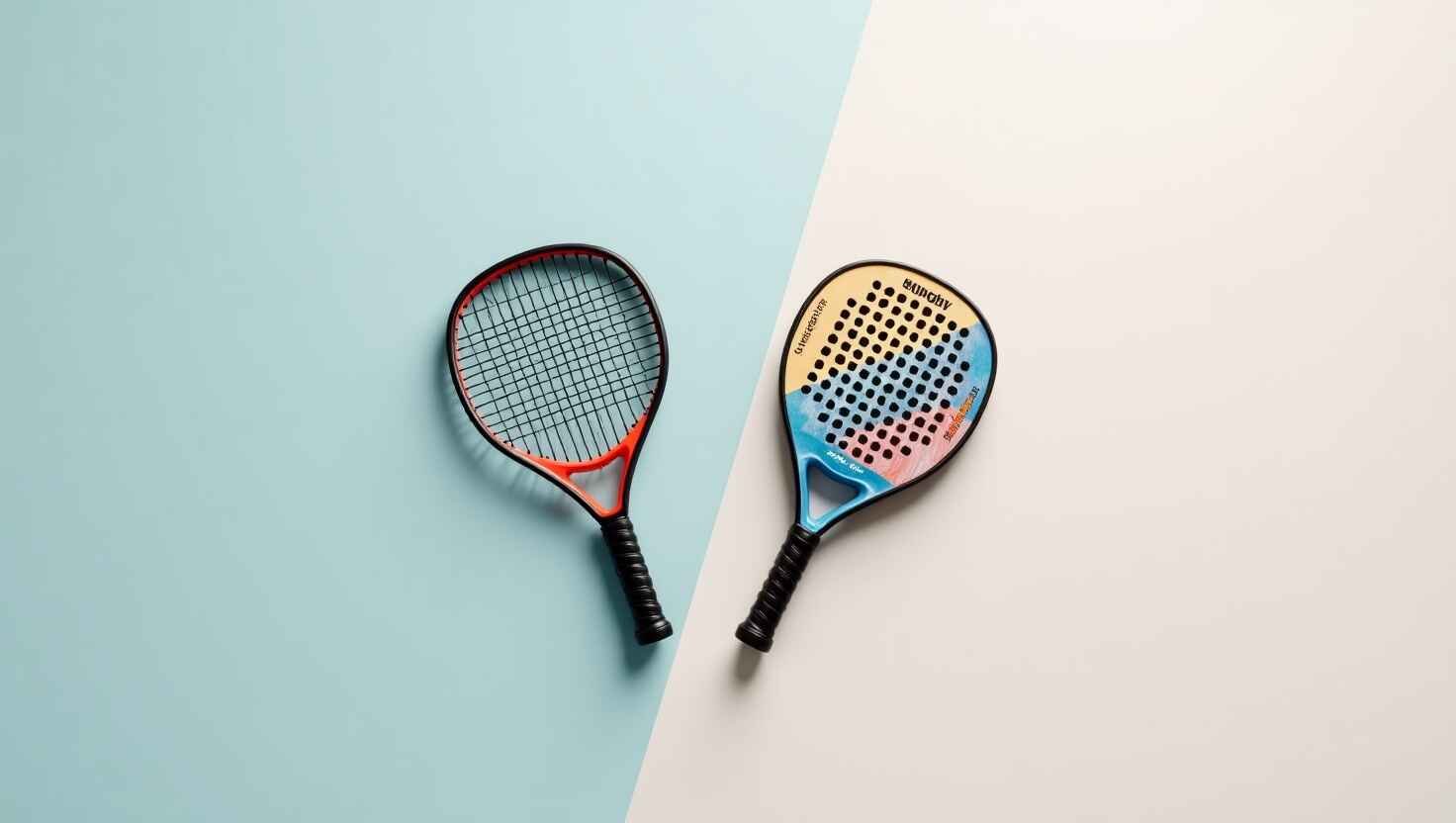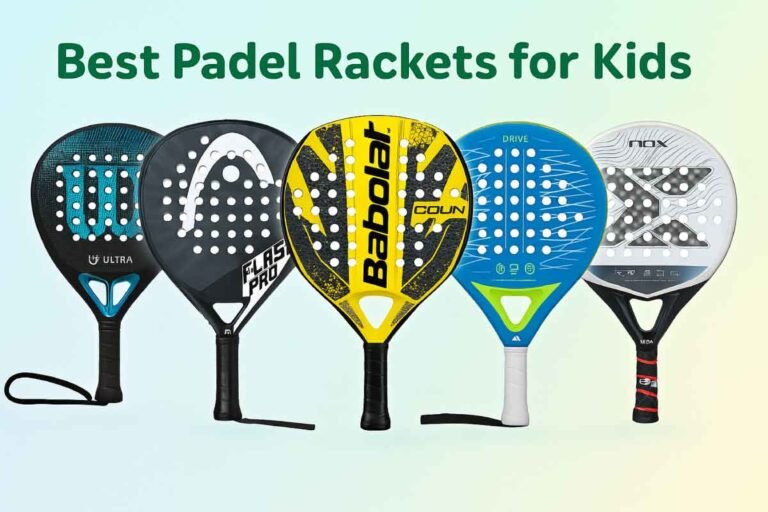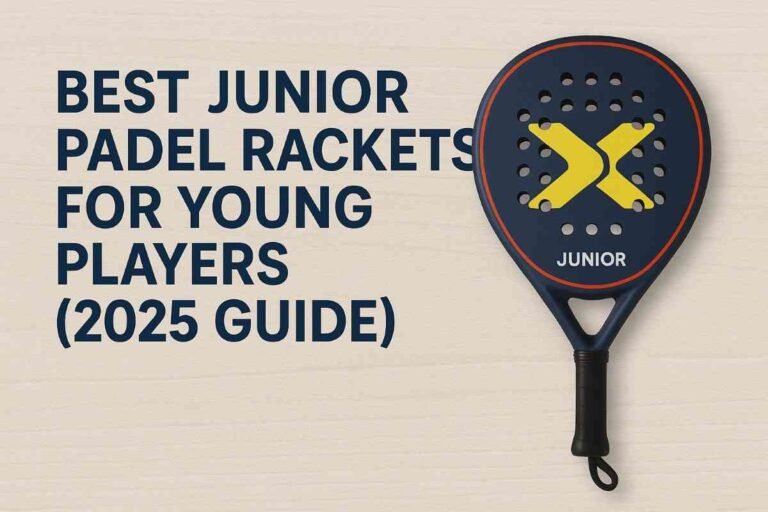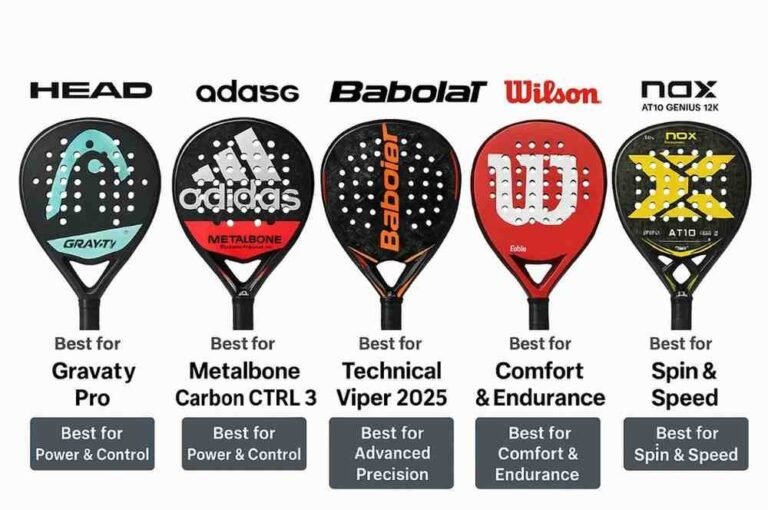Many new padel players wonder: Can you use a tennis racket for padel? While both rackets may seem similar, they are designed for different sports. Using a tennis racket on a padel court can negatively impact gameplay and performance and cause injuries.
A padel racket is shorter, solid, and perforated with holes to optimize control and maneuverability. A tennis racket has a long frame with strings that generate power and spin, making it unsuitable for padel’s enclosed court dynamics. Understanding these key differences will help you avoid mistakes and improve your game.
This article will explain why tennis rackets don’t work for padel, the key differences between both rackets, and what you should use instead. By the end, you’ll know exactly what makes a padel racket unique and which one to choose for better performance.
Is It Possible to Play Padel with a Tennis Racket?
Technically, you can use a tennis racket to play padel, but it’s far from ideal. Padel is a unique sport with different rules, court size, and playing mechanics. Tennis rackets are designed for power and long-range shots, while padel rackets focus on control, maneuverability, and precision in a compact court.
Why a Tennis Racket Won’t Work Well for Padel
A tennis racket is unsuitable for padel because of the fundamental difference in design, weight distribution, and materials. Let’s break it down:
1. Size & Shape Differences
- A tennis racket is longer (27 inches) and has a large stringed surface, allowing for powerful, high-speed shots.
- A padel racket is shorter (18 inches) and has a solid hitting surface, built for quick reactions and better control.
2. Control vs. Power
- Padel requires fast wrist movements and control, which a heavy tennis racket makes difficult.
- Tennis rackets generate more power but less precision, which leads to inconsistent shots in padel.
3. Court Limitations
- Padel is played in an enclosed court with walls, meaning players must hit off the walls and react quickly.
- A tennis racket’s more extended handle makes it difficult to perform accurate close-contact shots.
4. Injury Risks
- The weight and balance of a tennis racket are optimized for long swings, which can strain the wrist and elbow when used for padel’s short, controlled shots.
- Prolonged tennis racket use in padel can lead to wrist pain, tennis elbow, and reduced mobility.
While you can physically use a tennis racket in padel, it’s highly discouraged. You’ll struggle with control, reaction time, and maneuverability, making the game more frustrating and less enjoyable. Instead, invest in a proper padel racket designed for the sport—it will enhance your performance and reduce the risk of injury.

Key Differences Between a Tennis Racket and a Padel Racket?
Although tennis and padel rackets may look similar, they are built for different playing styles. Understanding these differences is essential to deciding between the two for padel.
Size and Shape
A tennis racket is significantly larger than a padel racket. The longer frame and extended handle allow for intense, full-range swings in an open court. On the other hand, Padel rackets are shorter and more compact, making them easier to maneuver in tight spaces and when returning shots off the walls.
The solid face of a padel racket eliminates the trampoline effect found in tennis rackets, offering more controlled hits.
Hitting Surface and Materials
The most apparent distinction is the tennis racket’s stringed surface versus the padel racket’s perforated solid face. Tennis rackets use interwoven nylon or polyester strings, designed to generate spin and power.
In contrast, padel rackets with carbon fiber, fiberglass, or foam cores absorb impact and provide more precision. The holes in padel rackets further reduce air resistance, improving aerodynamics.
Weight and Balance
A tennis racket is generally heavier (around 300–350g) and designed for power-based strokes, requiring full-arm movements. A padel racket is lighter (typically 340–390g) and more balanced, allowing quicker reaction times.
The lighter frame makes padel rackets easier on the wrist and elbow, reducing the risk of injury.
Handle Length and Grip
Padel rackets have shorter handles and are designed for wrist-based control and quick reflexes. A tennis racket’s longer grip allows for two-handed backhands, but this isn’t necessary in padel, where single-handed shots are the norm.
Impact on Playing Style
Since tennis focuses on power and baseline shots, players rely on the racket’s string tension and frame flexibility. Padel demands control, precision, and quick volleys, making a padel racket’s solid face and compact design far more effective. Using a tennis racket for padel can slow reaction times, decrease accuracy, and make gameplay more physically demanding.
Why Using a Tennis Racket for Padel Can Be a Disadvantage?
At first, it might seem like a tennis racket could work for padel, but playing with the wrong equipment can negatively impact performance, control, and physical well-being. A tennis racket is designed for a different sport, making it unsuitable for padel’s fast-paced, close-range nature.
1. Lack of Control and Precision
Padel requires short, controlled strokes because of the enclosed court and wall rebounds. Tennis rackets are too powerful and lack the precision needed for padel rallies. Since tennis rackets have strings, the trampoline effect reduces accuracy, challenging the execution of controlled volleys, lobs, and drop shots.
2. Increased Risk of Injury
A tennis racket’s longer handle and heavier weight can strain the wrist, elbow, and shoulder, leading to conditions like tennis elbow. Since padel relies on wrist flicks, quick reflexes, and short swings, using a tennis racket increases joint stress, leading to discomfort or injury over time.
3. Slower Reaction Time
Padel requires fast reactions at the net and along the walls. Tennis rackets are longer and harder to maneuver, meaning players struggle to return quick volleys. A padel racket’s compact shape and lighter frame allow quicker responses during fast-paced exchanges.
4. Difficulty Generating Spin
Padel rackets with textured surfaces help players generate topspin and backspin on the ball. Tennis rackets rely on string tension for spin, which doesn’t work the same way in padel. Shots will feel less controlled and may lack the desired spin effect, impacting placement and strategy.
5. Air Resistance and Swing Effort
The perforated holes in a padel racket reduce wind resistance, making it easier to swing efficiently. Tennis rackets are bulkier and less aerodynamic, meaning players must exert more effort per swing, causing unnecessary fatigue.
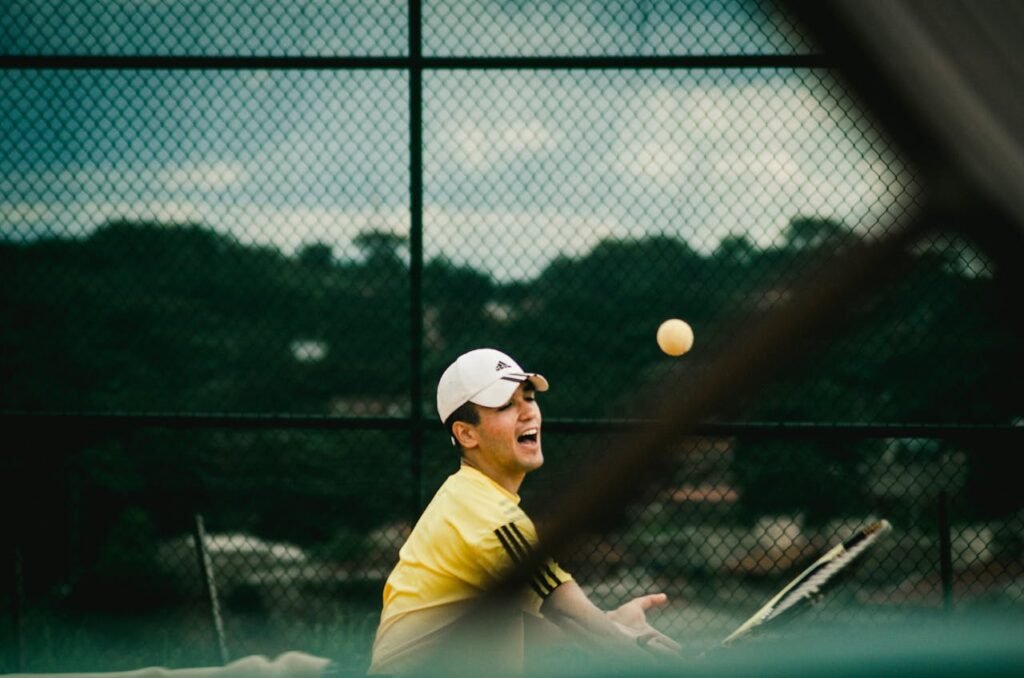
What Happens If You Use a Tennis Racket in a Padel Game?
Using a tennis racket in a padel match might seem like a fun experiment, but it creates major gameplay issues that can make the experience frustrating and ineffective. The weight, size, and design differences significantly impact movement, shot execution, and overall performance.
1. Difficulty Controlling the Ball
Padel rackets are designed for short, controlled strokes, while tennis rackets are built for powerful, long-range shots. If a player tries using a tennis racket in a padel match, the ball will likely bounce unpredictably due to the racket’s string tension and larger head size. Drop shots, volleys, and lobs become more challenging to execute accurately.
2. Increased Unforced Errors
Since padel courts are enclosed, ball control is key to avoiding unnecessary mistakes. A tennis racket’s extra power makes it easy to hit the ball too hard, causing it to bounce off the walls uncontrollably or sail out of bounds. Players might lose points due to excessive power and lack of precision.
3. Slower Defensive Play
In padel, quick reactions and defensive play near the walls are essential. A tennis racket’s more extended handle and heavier frame slow down reaction time, making it harder to return fast shots, especially near the net. Players may struggle to adjust their swings and move efficiently around the court.
4. Higher Risk of Injury
The wrist and forearm motions in padel differ entirely from those in tennis. A tennis racket requires a full swing, whereas padel involves flicks and compact strokes. Using a tennis racket can strain the wrist and elbow, leading to fatigue or long-term injuries like tennis elbow.
5. Inefficient Spin and Shot Variety
Padel relies on spinning the ball to control pace and shot placement. Since tennis rackets are strung differently and lack a textured surface, spins are harder to generate. Players lose tactical advantages, such as effective topspin lobs or slice shots against the walls.

Can You Modify a Tennis Racket for Padel?
Some players might wonder if modifying a tennis racket could make it more suitable for padel. While specific adjustments can be made, a tennis racket will never fully match the performance of a real padel racket. The structural differences between the two sports make conversion ineffective and impractical.
1. Reducing String Tension
One way to modify a tennis racket is by loosening the string tension to reduce the power and increase control. However, this doesn’t solve the issue of size and weight distribution. Even with adjusted tension, a tennis racket still delivers excessive power, making it difficult to execute precise padel shots.
2. Shortening the Handle
Some players attempt to shorten the handle of a tennis racket to mimic the compact grip of a padel racket. While this might improve maneuverability, the racket remains too large and heavy. The increased weight slows reactions and affects wrist movements, which are crucial in padel.
3. Adding a Rough Surface for Spin
Padel rackets have textured faces to generate effective spin and ball control. Tennis rackets have smooth string beds, making spinning the ball harder in padel. Some players try to apply rough adhesives or modify the surface, but this rarely replicates the real feel of a padel racket.
4. Adjusting the Balance and Weight
Padel rackets are lighter and more balanced for quick reactions. Some players attempt to remove weight from a tennis racket by modifying the frame or grip. While this may help slightly, it compromises racket stability and alters the natural feel, making it uncomfortable for both padel and tennis.
Is It Worth Modifying a Tennis Racket?
Even with these modifications, a tennis racket doesn’t perform like a real padel racket. Instead of altering a tennis racket, investing in an entry-level padel racket is a far better option. Padel rackets are designed for the sport, offering better control, comfort, and gameplay advantages.
Conclusion: Why You Should Use a Padel Racket Instead
While using a tennis racket for padel may seem convenient, the design differences make it a poor substitute. Padel requires precision, agility, and control, which a tennis racket can’t provide. Even with modifications, a tennis racket will never match a real padel racket’s balance, maneuverability, and shot accuracy.
Using a tennis racket in padel creates unnecessary challenges and can lead to injuries due to its weight and incorrect balance. Padel rackets are lightweight, properly shaped, and designed for padel gameplay, making them the best choice for any player, beginner or professional.
The Smarter Choice: Invest in a Padel Racket
Instead of adapting a tennis racket, investing in a quality padel racket is better. Affordable beginner-friendly models offer better performance, control, and durability. Choosing the right racket enhances gameplay, prevents injury, and helps develop proper padel techniques.
If you’re serious about playing Padel the right way, switch to a proper Padel racket today!
Popular Padel Rackets
- Head Gravity Pro 2024 Padel Racket – Best for Balanced Control
- Head Radical Pro Padel Racket – Best for Power & Spin
- Head Speed Motion 2023 Padel Racket – Best for Speed & Precision
- Adidas Metalbone Carbon CTRL 3.3 Padel Racket – Best for Power & Control
- Adidas Adipower Ctrl 3.2 Padel Racket – Best for Precision & Comfort
- Babolat Technical Viper 2024 Padel Racket – Best for Advanced Precision
- Babolat Counter Veron 2024 Padel Racket – Best for Balance & Defense
- Wilson Bela Pro V2.5 Padel Racket – Best for Comfort & Endurance
- Wilson Carbon Force Padel Racket – Best for Stability
- Nox AT10 Genius 12K Padel Racket – Best for Spin & Speed
Ready for More? You’ll Love This Insight
FAQs
Technically, you can play padel with a tennis racket, but it is not recommended. A tennis racket’s weight, size, and string tension make it challenging to control shots, reducing precision and power. A padel racket is designed for the sport, offering better maneuverability, comfort, and gameplay efficiency.
A tennis racket is larger, heavier, and has strings, while a padel racket is solid, smaller, and made of foam-core materials. Padel rackets offer better control and spin for the unique playing style of padel, whereas tennis rackets are designed for long-range and high-speed ball striking.
Using a tennis racket in padel can lead to poor performance and injury. The extra weight and more extended handle affect shot precision, wrist movement, and overall control. Additionally, the lack of holes in a tennis racket creates more air resistance, making it harder to react quickly on the court.
No, modifying a tennis racket for padel is not practical. The structural differences, including weight distribution, material composition, and hitting surface, make it impossible to achieve the same feel and playability as a real padel racket. Investing in a proper padel racket is always the best choice.
Using a tennis racket is not allowed in official Padel matches, as it does not meet the regulations set by the Padel governing bodies. You may be disqualified from the match if you attempt to use a tennis racket. Playing with the correct equipment for safety and performance is always best.
